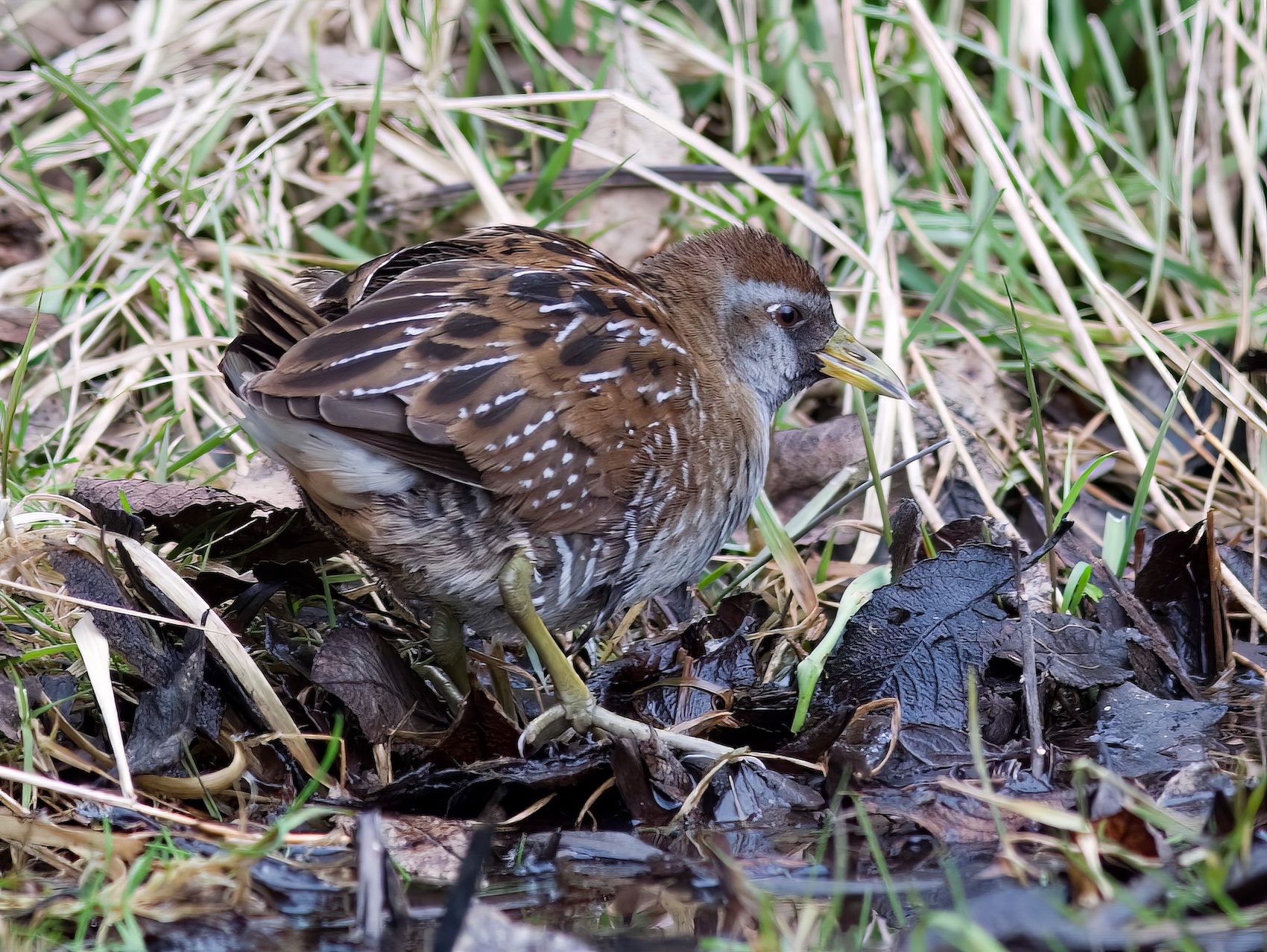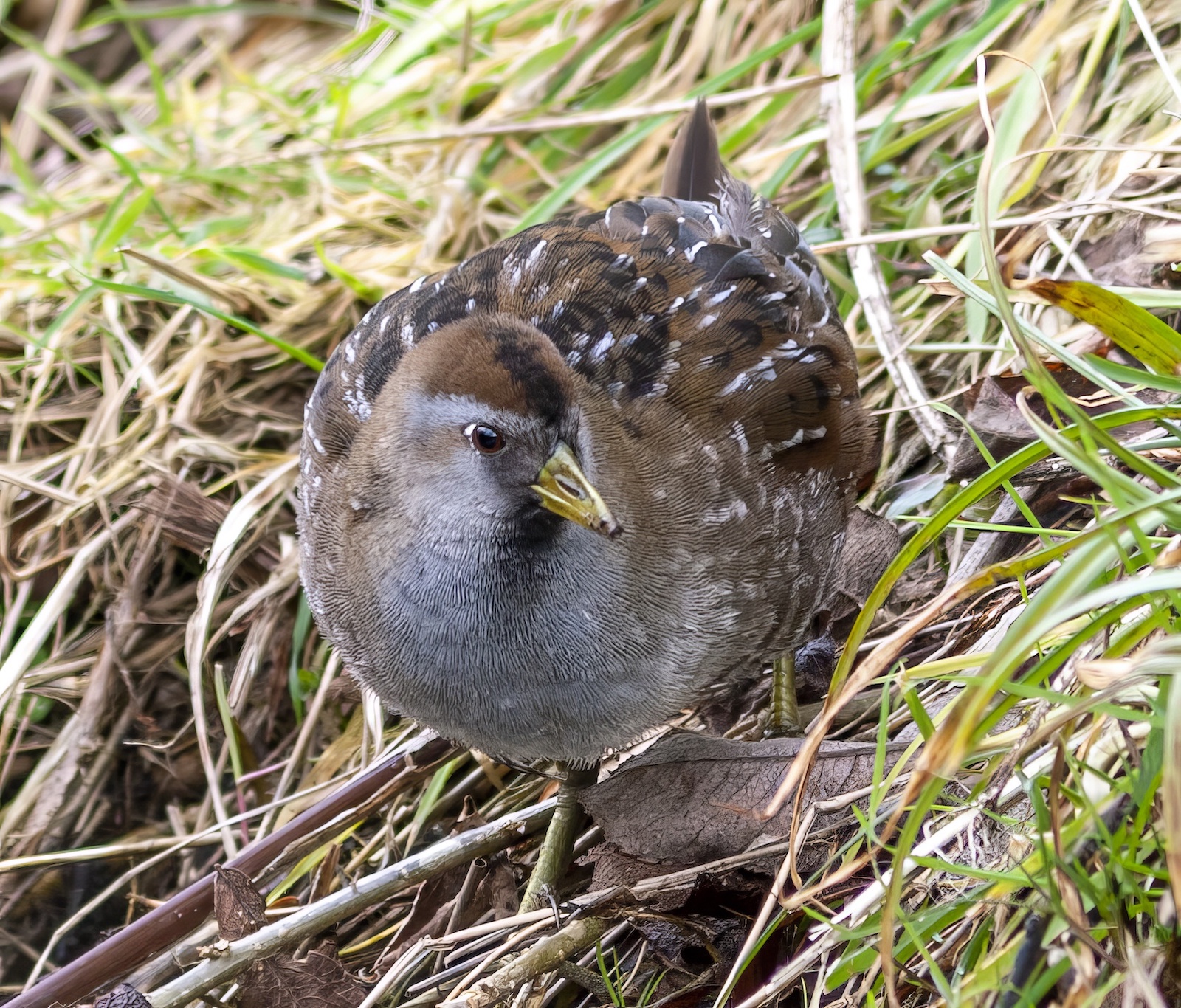Sora Porzana carolina


This was a surprise county first, discovered by GPBO staff while they were attempting to catch Moorhens and Water Rails at Gibraltar Point on March 5th 2006. The bird was trapped and ringed on March 17th, being identified as a first calender year female; it was present until March 18th. The only other Sora caught and ringed in the UK was an adult on Bardsey Island August 5th 1981.
Sora's breed in North America from Central Canada south to Central California and Maryland, USA. They migrate to winter from southern USA to Central America and northern South America. This was the sixteenth occasion this species had been recorded in Britain, and the eleventh since 1950. Up to 2016, two more have occurred. Most have been found during late September and October, while the few discovered in winter or spring are presumed to have arrived during the previous autumn. The majority of those recorded in Britain have been first year birds (10 out of 15 for which ages were recorded) but the proportion of adults (one third) is perhaps surprisingly high for a transatlantic vagrant. Less surprisingly, most have been found on the west coast, including seven on the Isles of Scilly, but a few have been further east including the first record, in Berkshire in 1864, and one in Nottinghamshire in 2004.
Adults are relatively easy to identify, but immatures are more challenging (Finland’s first Sora was apparently misidentified as a Little Crake for a few days). At-a-glance separation from the similar Spotted Crake is perhaps best achieved by noting the absence of both spotting on the face and transverse white bars on the tertials – both of which are usually obvious on immature Spotted Crakes.
| Site | First date | Last date | Count | Notes |
| Gibraltar Point NNR | 05/03/2006 | 18/03/2006 | 1 | 2CY female, trapped and ringed 17/03/2006. |
Finder’s report: Sora at Gibraltar Point, March 5th, 2006, first county record
by K. M. Wilson
Note: This account is based on the ‘Finders Report’ which appeared in the Lincolnshire Rare & Scarce Bird Report 2003-2007. The BBRC report for 2006 noted that the majority of records are of first-winters found in reedbeds at migrant traps from late September to November, while the few overwintering birds are presumably ones that arrived the previous autumn undetected.
Circumstances
The eastern section of the borrow pits at Gibraltar Point narrows down to a 70m secluded ditch, an attractive site for Water Rail and Moorhen in the winter months. Much of the ditch can be viewed in both directions from a small bridge that provides access to the Fenland Lagoon. Tim Bagworth (TB) and Mick Briggs had attempted to trap and ring Moorhen and Water Rail here, mostly unsuccessfully, during the winter. On the bitterly cold morning of March 5th, TB had completed a ringing session in the dunes before moving to the borrow pits. On his way there a birdwatching couple had informed him of a Spotted Crake seen by the borrow pit bridge. TB was soon at the bridge and after a ten minute wait the crake appeared at 12.50 hr. TB immediately contacted Paul Troake (PMT) who also came to look. Kev Wilson (KMW) had been away for the morning but was contacted by phone on his way back from Horncastle. TB started to take notes and photographs of the crake and began to doubt the identification of Spotted Crake. He raised the possibility that it was a Sora with PMT who rang KMW to discuss the identification as he had seen two previously in the UK. From his memory the principal features were the bill structure and lack of red at the base, dusky smudging around the face and throat and throat, and lacking the spotty appearance of Spotted Crake. PMT was fairly sure that these features matched the Gib bird. KMW then rang Mark Edgeller for further advice, who was able to quickly refer to field guides and give other identification pointers such as the crown and tertial colouration. However, the bird had gone missing now. It was presumed to have moved west down the ditch system where viewing was more constrained.
KMW arrived on site at 15.00 hr. and there was still no sign of the bird. The small number of people looking had filtered west along the track hoping that it would appear in a large open bay with rush fringing. After 30 minutes however, KMW returned to the bridge to see if it had gone back to the original site. There it was – a Sora, about 8m away creeping along the ditch margin where the ice had melted.
With the identification agreed the news was phoned in to Birdline Northeast and from there nationally. Unfortunately, the Sora went back into thick cover and was not seen after 16.10 hr. that day. The following day KMW returned to the site at dawn to organise viewing for birders. He need not have been concerned; other than Gib staff and volunteers only two birders were present with the furthest having come from Boston. This was much the same situation as the 2002 Red-flanked Bluetail.
As the sun rose and warmed the ditch banks the Sora materialised and showed well from 07.01 to 07.30, with a later appearance at 09.00 hr., before going missing until 17.00 hr. when it was refound some 200m away along Mill Pond ditch where it was easily disturbed. As a twitch scenario started to develop it was decided that the best course of action would be to put some scraps of food down for the crake to lure it to the bridge area which was the best vantage point for birders. Over the course of the next few days the Sora duly paid early morning visits to this site and was rarely seen at other times or in other places.
Site staff and volunteers paid daily visits to the site to supervise watching where necessary. Often only 10 people could view the bird simultaneously. Fortunately, the bird did perform briefly for the largest crowd of about 70 birders the following Saturday morning, 11th. Alas, the wooden bridge was overloaded and took on a heavy list (It had to be completely replaced after the event).
During the latter part of its stay the bird attracted few visitors and in the more relaxed situation some good photographs were obtained, and the opportunity was taken to trap the bird at the baiting site. This was done with ease on 17th. The bird was found to be a 2CY (1stW) female and judged to be in very good condition for migration. It was released back on the ditch system immediately after being processed and showed well there for the rest of the day, although it was occasionally harassed by a local Moorhen. The feeding regime ceased subsequently, and the bird later dispersed further west down the borrow pit system. It was last seen on 18th although this area was not thoroughly checked subsequently.
As well as being the first for the reserve the Sora was a first for Lincolnshire. It was a most unusual occurrence on the east coast of the UK but followed an individual at Attenborough, Nottinghamshire in December 2004.
Description
It was quite a chunky crake with a thick-based bill. Head and upperparts – showed warm brown tones around the head with a dark centre to the crown. Black markings around the lores and throat were quite subdued compared to full adult plumage, but traces of dark feathers could be seen well on to the upper breast. The upperparts showed a series of silvery-white lines formed by edgings of many of the feather tracts including scapulars and tertials. From behind the underside of the cocked tail was white with a buffy ventral area.
Reference
Wilson, K. (undated) Sora Rail first for Gibraltar Point and Lincolnshire, March 5th-18th 2006. Lincolnshire Rare & Scarce Bird Report 2003-2007, 159-160.
(Account prepared November 2017; updated with reference to the new Birds of Lincolnshire (2021) October 2022)

